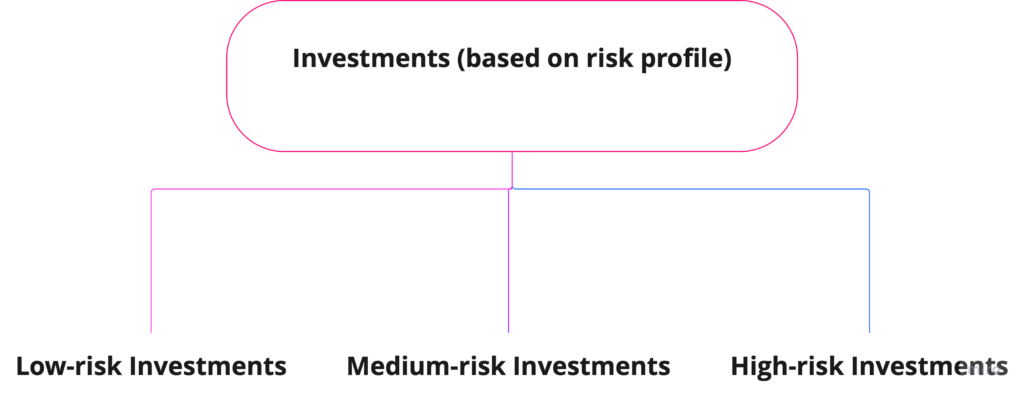Investment means allocating some of your income to different assets to grow your wealth over time. But each investment carries different risks. You need to be aware of your financial goals and risk tolerance.
In today’s fast-moving world, it is essential that you start investing so you can build a corpus to fulfil all your financial goals. Let’s read more about what an investment is and its various types.
What is investing?

Investing refers to allocating a part of your income to a project or security – broadly called an investment – for a specific period of time. Investing aims to earn returns on the amount you have invested in growing your wealth over time.
This is essential to build financial security, as money left idle often generates no returns and can lose value due to inflation over the years.
Investment – Main Highlights
- Investing means putting a part of your income into specific assets in order to generate positive returns over time.
- The returns that can be generated depend on the kind of asset you invest in and the risk you are willing to take.
- Higher the investment risk, the higher the returns.
- Investing is not the same as saving.
Types of investments
The various types of investments include:
- Stocks
Stocks are units of equity in a company. They are traded on the stock exchange and can also offer dividend income.
- Bonds
Bonds are debt that the companies and the government draw from various stakeholders with a fixed maturity and interest rate.
- Mutual funds and ETFs
These funds come in different types. Based on how much you want to invest, you can pick a suitable fund and make your investment plan accordingly. You can also start a SIP and invest a pre-decided amount every month.
- Real estate
You can invest and buy your own property, which can be rented out to earn regular returns.
- Gold
Gold is a great way to diversify your portfolio. Gold is generally used as a hedge against market movements.
- Bank deposits
You can put your funds in different bank deposits and earn a fixed return, free from risk. Some examples are fixed deposits and recurring deposits.
- Saving schemes
The Government launches various savings schemes that are risk-free and give good returns, along with tax benefits. For example, PPF accounts and the Sukanya Samridhhi Yojna.
How to invest?
You can follow the given steps to build your investment strategies:
- Identify your financial goals
The first step is to determine what your goals are. This helps you create a timeline for your investment and determine the funds you will require in the future. These goals can be short-term or long-term, such as planning your wedding or retirement.
- Assess your risk appetite
Every investment comes with a different level of risk. For instance, stocks are considered highly risky, as returns aren’t guaranteed. On the other hand, Government bonds are typically risk-free. Your risk appetite determines what investments you can choose from.
- Explore your options
There are several investment options in the market. Some types of investments have been discussed above. Explore your options and choose what best suits your financial goals and risk appetite. You may also seek help from a financial advisor for the same.
- Allocate a part of your income to investing
Once you have determined how much you wish to accumulate, you must ascertain the quantum of your investment. Moreover, you must factor the investment amount into your monthly budget.
How does risk appetite affect your investment choices?
The way you allocate your funds in different investments depends on the risk you are willing to take. Investments such as stocks and ETFs are market-linked and are affected by market fluctuations, making them risky. On the other hand, putting your money in a PPF account or a fixed deposit keeps it relatively safe.
When you are young, you may have a higher risk appetite, allowing you to take on investments that involve greater risk. But as you grow older, reducing your risk appetite and making risk-free investments can be ideal.
Types of investments based on the risk profile

Low-risk investments
Low-risk investments carry less exposure to risk. These are free from market fluctuations and provide a steady return. However, the returns can be lower. For example, Fixed deposits, Government bonds, PPF accounts, and saving schemes are considered safer investments but do not offer significant returns.
Medium-risk investments
Medium-risk investments are those that carry moderate risk and returns. These are great investment options for those looking to grow their wealth while not exposing themselves to a high level of risk. Some medium-risk investments can include mutual funds and blue-chip stocks.
Visit Tickertape’s Stock Screener to find the most popular blue chip stocks. There are over 200 filters, like market capitalisation, P/E ratio, etc., to find the best stocks.
High-risk investments
High-risk investments are those that offer high returns but come with an increased degree of risk. Only investors with a solid financial footing and high-risk appetite must consider these. For example, options contracts, high-yield bonds, and some types of mutual funds.
Reasons to start investing today
The earlier you start investing, the more returns you can earn. If you haven’t started yet, you can start now. Here are some reasons why you should start investing today:
- To get the benefits of compounding
- To save for retirement
- To take advantage of market movements to gain profits
- To ride out market fluctuations
The difference between savings and investment

| Basis | Savings | Investment |
| Aim | Savings are short-term investments used to fulfil your immediate goals and needs. | Investment is made for bigger goals that are lined up in the long term. |
| Returns | By keeping your savings in a savings account, you can earn a minimum amount of interest. | The returns involved are higher and depend on the kind of investment made. |
| Risk involved | Savings involve negligible risk, as most saving instruments come with guaranteed returns. | Most investments involve higher risk as they are affected by changes in the market. |
| Effect of inflation | Returns earned on savings barely cover the effect of inflation. | Investments offer higher returns that can protect you against rising inflation. |
| Liquidity | Instruments that aid savings are highly liquid. This allows you to cash in on them at any time to fund your immediate needs. | Investments are less liquid, and you must build an emergency fund alongside investing to park funds for immediate use. |
| Types of instruments | Savings account, marketable securities. | Real estate, gold, stocks, bonds. |
Conclusion
Investing allows you to allocate your resources to assets and securities to earn higher profits and fulfil short-term and long-term goals. But you must carefully analyse your risk appetite and financial goals before investing in a scheme, fund or stock. Consult your investment advisor before investing.



